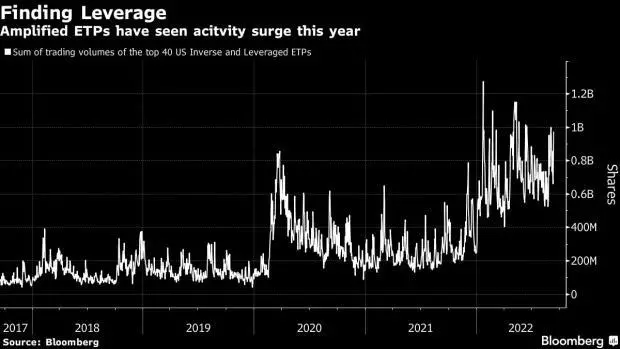New York September 14 2022: In Tuesday’s tumultuous trading session was a pattern market watchers have seen time and again this year: A bad day for stocks gets worse, right around the close. Suspicion is growing that a breed of complex but increasingly popular ETF may be helping fuel the trend, reported by Bloomberg.
With the main equity gauges all down heavily on the day, leveraged exchange-traded funds — which use options to amplify returns, usually of major indexes — added around $15.5 billion of selling pressure to the rout, according to estimates from Nomura Holdings Inc. It’s likely a big reason why stocks took another dip in the last 30 minutes to close out a particular brutal trading session.
While the propensity of options to lash the very stocks on which they’re based has become a fact of life on Wall Street, doubts have remained about the capacity of leveraged vehicles to do the same.
Yet trading volumes across these complex products have been historically high all year. Certain peaks, such as in May and June, corresponded with instances of stocks extending their moves near the end of the session.
“It’s absolutely real,” said Charlie McElligott, a cross-asset strategist at Nomura, referring to the ability of leveraged ETFs to spur broader moves across the equity ecosystem thanks to their rebalancing moves. He puts the boom in such products down to retail investors looking for big wins.
“Day traders remain drunk on high intraday vol and continue to actively seek-out large price swings,” he said by email.
Leveraged products aim to amplify the performance of an underlying index or fund on a daily basis, meaning every day they must rebalance to return to their target leverage — usually two- or three-times the underlying.
That means in the last 30 minutes of trading every day, this cohort will add to buying pressure if the market is up, and to selling pressure if it’s down. Research published earlier this year found that, alongside options hedging, leveraged ETFs exert an “economically large” price pressure late in the day.
The selling pressure at the close Tuesday was real, albeit far from dramatic relative to late-session swings seen earlier this year. The S&P 500 was about 4% lower with 30 minutes still to go. It ended 4.3% down. The Nasdaq 100 Index closed 5.5% having been down 5.3%. The Dow Jones Industrial Average went from a 3.7% drop to a 3.9% decline.
Of course, there are plenty of reasons equity gyrations are extending late in the day with increased frequency. Endless inflation, surging bond yields and depleted liquidity are all spurring big momentum trends as well as intraday rallies and reversals across assets in this wild year. In this context, leveraged funds are just another factor for traders to consider.
Yet systematic risks linked to the cohort prompted both the Securities and Exchange Commission and the Financial Industry Regulatory Authority to announce potential new rules for the products in the past year.
Peter Tchir at Academy Securities is among those to note the uptick in leveraged ETF activity this year. In May he wrote that while such products are less powerful than in prior market dramas, they’re big enough to create “a limit down day” if they suffer outflows and rebalancing that accelerates broader selling.










